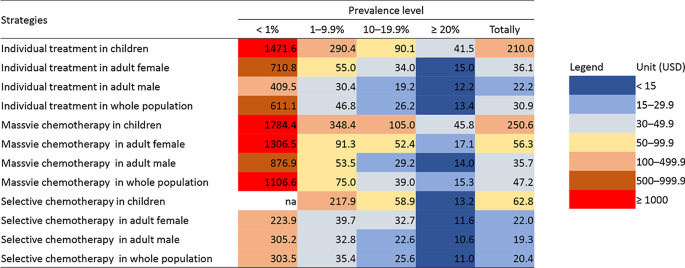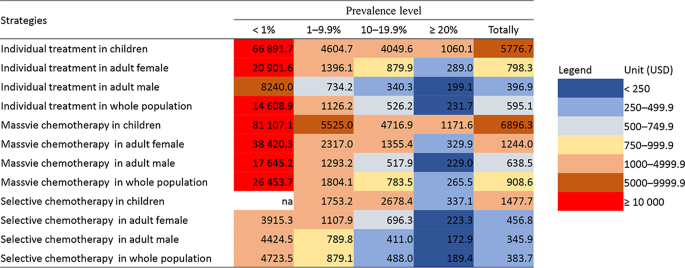Cost yield of different treatment strategies against Clonorchis sinensis infection - Infectious Diseases of Poverty - Infectious Diseases of Poverty - BioMed Central
Epidemiological profiles
The prevalence of C. sinensis infection and the proportion of persons ingesting raw freshwater fish refer to Additional file 1: Table S1 [17, 19]. The epidemiological profiles of C. sinensis prevalence and raw-freshwater fish-eating practice were similar in different endemic levels, namely higher prevalence of C. sinensis and proportion of raw-fish-eating practice in male compared to female and in elder people compared to children.
Overall, the DALYs per 1000 was 6.4, ranging from 0.2 to 34.3 in different counties. It was 0.5 in children ranging from 0 to 7.3, 4.6 in adult female ranging from 0 to 26.0, and 10.5 in adult male ranging from 0.2 to 42.9 (Additional file 1: Table S2). In adult female, the YLDs per 1000 was 4.3 and the YLLs per 1000 was 0.3. In adult male, the YLDs per 1000 was 9.7 and the YLLs per 1000 was 0.8.
Cost effectiveness
In very high prevalence group, cost to treat single infected case in selective chemotherapy was USD 10.6 in adult male, USD 11.6 in adult female, USD 13.2 in children and USD 11.0 overall (Table 1 and Fig. 1). Correspondingly, the cost increased to USD 22.6, USD 32.7, USD 58.9 and USD 25.6 in high prevalence group. In moderate prevalence group, the cost was USD 32.8 in adult male and USD 39.7 in adult female, while it exceeded USD 200.0 in children. In low prevalence group, the cost per infected cases exceeded USD 200.0 in all populations.

Cost effectiveness of different treatment strategies against Clonorchis sinensis infection. na not available
In massive chemotherapy, the cost in very high prevalence group was USD 14.0 in adult male, USD 17.1 in adult female, USD 45.8 in children and USD 15.3 overall (Table 1 and Fig. 1). In high prevalence group, the cost was USD 29.2, USD 52.4, USD 105.0 and USD 39.0 respectively. In moderate prevalence group, the cost was USD 53.5 and USD 91.3 in adult male and female, when it exceeded USD 300.0 in children. In low prevalence group, the cost exceeded USD 800.0 in any population.
In individual treatment, the cost in very high prevalence group was USD 12.2 in adult male, USD 15.0 in adult female, USD 41.5 in children and USD 13.4 overall (Table 1 and Fig. 1). The cost doubled nearly in high prevalence group compared to those in very high group. In moderate prevalence group, the cost further increased to USD 30.4 in adult male, USD 55.0 in adult female and USD 290.4 in children and USD 46.8 overall. In low prevalence group, the cost was over USD 400.0 in all populations.
Cost utility
In very high prevalence group, cost to avoid per DALYs in selective chemotherapy was USD 172.9 in adult male, USD 223.3 in adult female, USD 337.1 in children and USD 189.4 overall (Table 2 and Fig. 2). Correspondingly, the cost increased to USD 411.0, USD 696.3, USD 2678.4 and USD 488.0 in high prevalence group. In moderate prevalence group, the cost was USD 789.8 in adult male and USD 1107.9 in adult female, while it exceeded USD 1750.0 in children. In low prevalence group, the cost per infected cases exceeded USD 3900.0 in all populations.

Cost utility of different treatment strategies against Clonorchis sinensis infection. na not available
In massive chemotherapy, the cost in very high prevalence group was USD 229.0 in adult male, USD 329.9 in adult female, USD 1171.6 in children and USD 265.5 overall (Table 2 and Fig. 2). In high prevalence group, the cost was USD 517.9, USD 1355.4, over USD 4700.0 and USD 783.5, correspondingly. In moderate prevalence group, the cost exceeded over USD 1250.0 in all groups, when it was over USD 17 500.0 in any population in low prevalence group.
In individual treatment, the cost in very high prevalence group was USD 199.1 in adult male, USD 289.0 in adult female, USD 1060.1 in children and USD 231.7 overall (Table 2 and Fig. 2). In very high prevalence group, the cost increased to USD 340.3, USD 879.9, USD 4049.6 and USD 526.2, respectively. In moderate prevalence group, the cost further increased to USD 734.2 in adult male and over USD 1000.0 in other populations. In low prevalence group, the cost was over USD 8000.0 in all populations.
Composition of cost
In individual treatment, the overall composition was 81.6% in diagnosis (fecal examination), 17.4% in purchase of drugs, and another 1.0% in drug delivery (Table 3). The composition of diagnosis was highest in children (98.2%), followed by adult female (84.1%) and then adult male (74.1%). The percentage of diagnosis in overall population reached 57.2% in very high prevalence group, 78.3% in high prevalence group, 87.9% in moderate prevalence group and 99.1% in low prevalence group.
In massive treatment, the overall composition was 94.7% in purchase of drugs and another 5.3% in drug delivery (Table 3). The cost of purchase of drug was 91.8% in children, 94.6% in adult female and 95.4% in adult male. Because all persons in all populations received treatment and the cost in purchase and delivery of drugs was same, thus the composition didn't vary by prevalence in any single population. However, the cost changed a little in overall population by counties because of the different structure in population and different body weight in different populations.
In selective chemotherapy, the overall composition was 88.0% in purchase of drugs, 7.5% in diagnosis (behavioral screening), and another 4.5% in drug delivery (Table 3). The composition of purchase of drugs was highest in male (90.7%), followed by female (86.3%) and then children (33.0%). The percentage of purchase of drugs in overall population reached 91.7% in very high prevalence group, 89.0% in high prevalence group, 88.8% in moderate prevalence group and 55.3% in low prevalence group.
Comments
Post a Comment